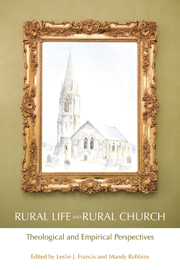Book contents
- Frontmatter
- Contents
- Preface
- Foreword by The Bishop of Shrewsbury, The Rt Revd Mark Rylands
- 1 Introduction: shaping rural theology
- PART 1 PERSPECTIVES FROM THE BIBLE
- PART 2 PERSPECTIVES FROM ORDINARY THEOLOGY
- PART 3 THEOLOGICAL AND SOCIOLOGICAL PERSPECTIVES
- PART 4 HISTORICAL PERSPECTIVES
- PART 5 LISTENING TO VISITORS
- 15 I was glad: listening to visitors to country churches
- 16 Sacred place and pilgrimage: modern visitors to the shrine of St Melangell
- 17 Visitor experiences of St Davids Cathedral: the two worlds of pilgrims and secular tourists
- PART 6 LISTENING TO THE COMMUNITY
- PART 7 LISTENING TO CHURCHGOERS
- PART 8 LISTENING TO CHURCH LEADERS
- PART 9 SATISFACTION AND STRESS IN MINISTRY
- Contributors
- Sources
- Subject Index
- Name Index
16 - Sacred place and pilgrimage: modern visitors to the shrine of St Melangell
from PART 5 - LISTENING TO VISITORS
- Frontmatter
- Contents
- Preface
- Foreword by The Bishop of Shrewsbury, The Rt Revd Mark Rylands
- 1 Introduction: shaping rural theology
- PART 1 PERSPECTIVES FROM THE BIBLE
- PART 2 PERSPECTIVES FROM ORDINARY THEOLOGY
- PART 3 THEOLOGICAL AND SOCIOLOGICAL PERSPECTIVES
- PART 4 HISTORICAL PERSPECTIVES
- PART 5 LISTENING TO VISITORS
- 15 I was glad: listening to visitors to country churches
- 16 Sacred place and pilgrimage: modern visitors to the shrine of St Melangell
- 17 Visitor experiences of St Davids Cathedral: the two worlds of pilgrims and secular tourists
- PART 6 LISTENING TO THE COMMUNITY
- PART 7 LISTENING TO CHURCHGOERS
- PART 8 LISTENING TO CHURCH LEADERS
- PART 9 SATISFACTION AND STRESS IN MINISTRY
- Contributors
- Sources
- Subject Index
- Name Index
Summary
Abstract – The two concepts of sacred place and pilgrimage are explored in relation to the shrine of St Melangell at Pennant Melangell in Mid Wales. An empirical study was mounted during the first three months of 2004 when visitors to the shrine were presented with a questionnaire to ascertain their reactions to sacred place and pilgrimage stimulated by their visit. analyses of resulting data show that many visitors today are aware of sacred place and can be described as being on pilgrimage. Data also show possibilities for energizing small local rural churches which at the present time might be in danger of redundancy.
Introduction
Jones (2002) identifies nine functioning centres of modern pilgrimage in Wales of which four are particularly popular. The principal one is that of David, the nation's patron saint, located in the West Wales cathedral town that bears his name. Winifred's shrine at Holywell on the Dee Estuary in North Wales, has the longest history of continuous pilgrimage and enjoys increasing popularity today. In a more remote location off the Lleyn Peninsula is Bardsey Island, the shrine of Cadfan, the fifth century Breton saint. The fourth is the shrine of Melangell, set in a valley deep within the Berwyn mountains of Mid Wales.
- Type
- Chapter
- Information
- Rural Life and Rural ChurchTheological and Empirical Perspectives, pp. 188 - 200Publisher: Acumen PublishingPrint publication year: 2012



